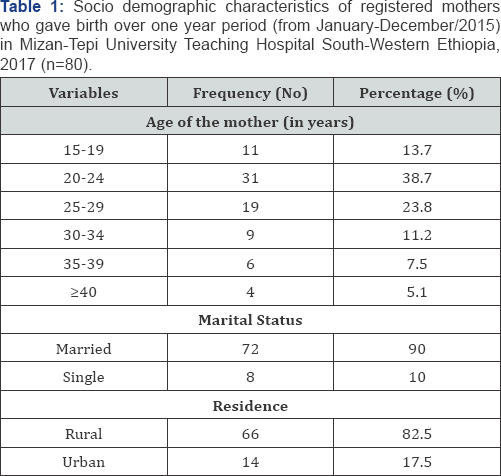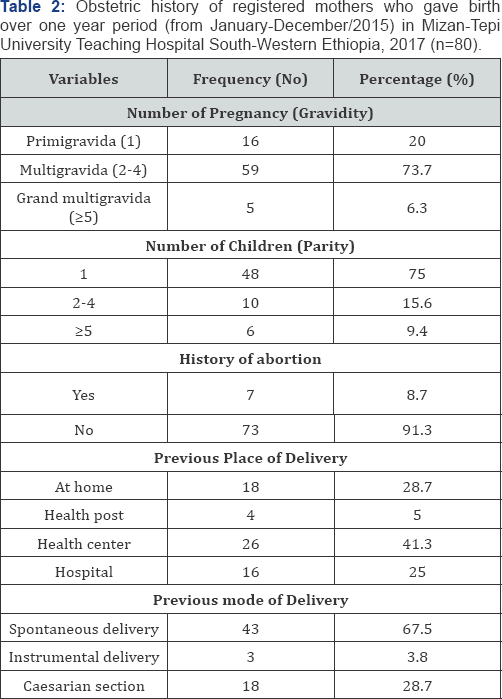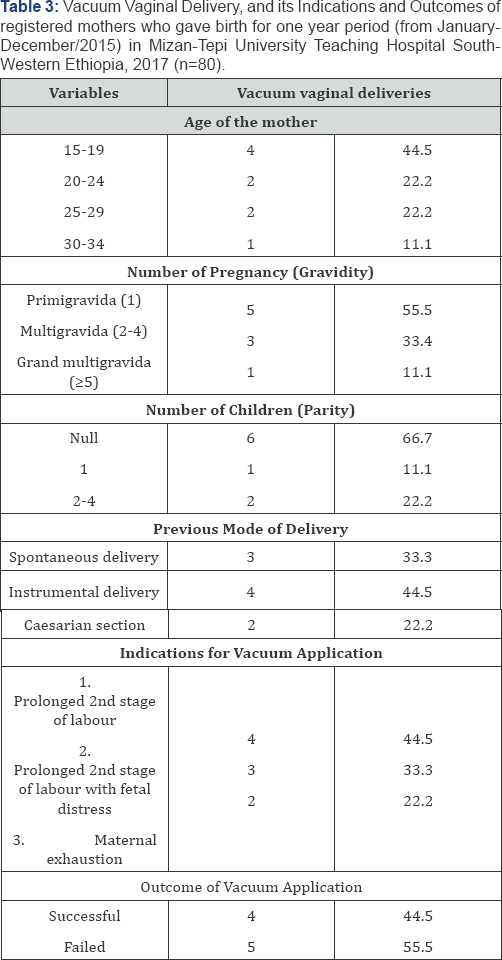The Prevalence of Vacuum Vaginal Delivery and ||| It's Indications and Outcome among Mothers Who Delivered in Mizan-Tepi University Teaching Hospital, Southwest Ethiopia, 2017. Retrospective CrossSectional Study
Daniel Shiferaw1* and Sileshi Toma2
1Department of Nursing, College of Health Science, Mizan-Tepi University, Ethiopia
2UNICEFproject implemented by Ethiopian midwife association, Ethiopia
Submission: July 10, 2017; Published: July 31, 2017
*Corresponding author: Daniel Shiferaw, Department of Nursing, College of Health Science, Mizan-Tepi University, Ethiopia, Email: danshif.78@gmail.com
How to cite this article: Daniel S, Sileshi T. The Prevalence of Vacuum Vaginal Delivery and It's Indications and Outcome among Mothers Who Delivered in Mizan-Tepi University Teaching Hospital, Southwest Ethiopia, 2017. Retrospective Cross-Sectional Study. J Gynecol Women's Health 2017; 6(2): 555683. DOI: 10.19080/JGWH.2017.06.555683.
Abstract
Introduction: Vacuum extraction is a method of instrumental delivery which involves the use of a vacuum device as a traction instrument to assist delivery.
Objective: To determine the prevalence of vacuum vaginal delivery, and it's indications and outcome among one years registered mothers who delivered in Mizan-Tepi university teaching hospital, southwest Ethiopia, 2017.
Methods: Hospital based retrospective cross-sectional study was conducted among registered mothers who gave birth for one year period (2015) at Mizan-Tepi University Teaching Hospital with a total sample size of 80. A total of 1854 delivery were conducted in the hospital over this one year period and systematic randomized sampling technique was used and every 24th of the list was used to select the total sample size.
Result: From the total sample size vacuum vaginal delivery techniques were employed on 9 laboring mothers (11.25%). The indication for performing an assisted vacuum delivery, were prolonged 2nd stage of labour 4 (44.5%); prolonged 2nd stage of labour followed by fetal distress 3 (33.3%) followed by maternal exhaustion which was 2(22.2%). From total vacuum deliveries, 4(44.5%), were successful and 5(55.5%) were failed.
Conclusion and Recommendation: The prevalence of vacuum vaginal delivery was low. The commonest indication for vacuum delivery was prolonged 2nd stage of labour. High failure rate of vacuum extraction were documented and the mothers underwent an emergency cesarean delivery. Thus concerned stakeholders should address on provision of skill training in vacuum extraction techniques.
Keywords: Vacuum vaginal delivery; Mother; Mizan-Tepi University
Introduction
Vacuum extraction is a method of instrumental delivery which involves the use of a vacuum device as a traction instrument to assist delivery. Assisted vacuum vaginal delivery is necessary when laboring mothers are exhausted and fetal distress is occurred to bring good birth outcomes and save their lives [1,2].
The vacuum extractor has become more frequently used by obstetrician due to its apparent increased safety and easy to use, when compared with forceps [1].
Studies done in Europe and USA indicate that the prevalence of an operative vaginal delivery was 3.3 % [3] and implementation of vacuum vaginal deliveries ranges from 2.7%-8.6% [3-5].
In developing countries found in Africa and Asia showed that the prevalence of vacuum extraction ranges from 0.54%-15.4% [6-10]. The study reports showed that the commonest indication for the vacuum delivery was prolonged second stage of labour, fetal distress, followed by prolonged second stage and poor maternal effort. Thus instrumental delivery either vacuum or forceps helps in decreasing the caesarean section rate [6,7]. From those who conducted vacuum deliveries the successes rate reaches about 85.7% and the failed extractions were 14.3% delivered by caesarean sections [7]. The occurrence of complications with vacuum delivery were primary postpartum hemorrhage (9.5%), fetal complication (31%) and cephalhaematoma (18.1%) [7].
A study done in Ethiopia showed that the prevalence of vacuum vaginal delivery was 5.8%.The commonest indication of vacuum application was fetal distress 92(43%), prolonged 2nd stage 67(31.3%), to shorten the second stage 34(15.9%) and poor maternal effort 21(9.8%) [10].
Though the practice of vacuum extraction was is well implemented in the majority health institutions of the study area, research works on the prevalence of vacuum vaginal delivery and its indication and outcome was not conducted.
Methods and Materials
Study design and population
A hospital based retrospective study was conducted among registered mothers who gave birth over one year period (from January-December/2015) in Mizan-Tepi university teaching hospital south-western Ethiopia. Mothers who had a complete data on the delivery record book and patient card were considered in this study. The hospital's delivery record book of mothers who gave birth at the hospital in over one year period was used as a sampling frame. A total of 1,854 deliveries were conducted in the hospital over this three year period and systematic randomized sampling technique was used and from the sampling frame the first study unit was selected by lottery method and the rest was selected by every 24th interval of the sampling frame to select the total sample size. A total sample size of 80 was determined by using single population proportion formula by considering prevalence (proportion) of mothers delivered by vacuum extraction was 5.8% [10].
The study was conducted from February 15-30/2017.
Data collection instrument
A Structured check list was developed. The data was collected from delivery registration book and patient card. The data was first collected from the delivery registration book and then the patient's card was checked.
The data about current mode of delivery, the prevalence of vacuum vaginal delivery, its indication and outcome was taken from the delivery registration book. Whereas the patients Sociodemographic, obstetric and gynecologic history was filled from the patient card.
The check list two parts: Sociodemographic and obstetric questions; and indications and outcome of vacuum vaginal deliveries.
The check list was pre-tested on 5% of sample size a week before actual data collection period in other public hospital found in the study area and after pre-test necessary modification was done.
The check list was filled by trained midwifes hired from health centers and technical support was given by the Principal Investigator.
The study variables
Dependant variables: Prevalence and indication of vacuum delivery, Outcome of vacuum delivery
Independent variables: Age, Marital status, Parity, Number of pregnancy, Number of children, previous mode of delivery, Indication of vacuum application.
Data analysis procedure
The coded data was checked, cleaned and entered into Epidata version 3.1 and then exported into SPSS window version 20.0 for analysis. Descriptive study was done to determine the prevalence of vacuum vaginal delivery, and its indications and outcomes. Then the data was presented by statements and tables.
Operational definition
Vacuum delivery: A method of instrumental delivery which involves the use of a vacuum device as a traction instrument to assist delivery
Prevalence: The number of old cases, who delivered by vacuum delivery over one year period (from January- December/2015).
Indications: It's a prerequisite for vacuum delivery
Outcomes: Benefits and problems encountered by the mother and the fetus after the vacuum application.
Ethical approval
Before the data collection, Ethical clearance and Cooperation letter was written from Mizan-Tepi University, and then submitted to administration of Mizan-Tepi university teaching hospital for permission. The health workers especially those who were working in the labour and delivery ward were informed about the purpose of the study, and their cooperation was obtained. The data from the registration book and patient card was fully maintained and the information was kept strictly confidential by making each check list coded (no name of the client on the check lists) and not sharing personal information of any patient to the third party.
Results
Socio demographic characteristics

A total of 1,854 deliveries were conducted in the hospital over the one year period. In this study a total of 80 charts were reviewed. Most of the study subjects, 31 (38.7%), were 20-24 years of age; 72 (90.0%) were married women and 66 (82.5%) were rural dwellers (Table 1).
Obstetric history
Most of the mothers, 59(73.7%), who delivered in the hospital were primigravida and 53(66.3%) of the mothers was primiparas. Most of the mothers (91.3%) have no history of abortion. Among the multiparas, most of them have history of spontaneous vaginal delivery (67.5 %) at public health center (41.3%) (Table 2).

Vacuum vaginal delivery, and its indications and outcomes
Vacuum vaginal delivery techniques were employed on 9 mothers (11.25%) of the total sample size, 80 mothers. Among the mothers who delivered by vacuum delivery, 4(44.4%) were between 15-19 age group. Most of them were primigravida and has no child which was 5(55.5%) and 6 (66.7%) respectively. One mother who delivered by vacuum delivery had history of abortion. The indication for performing an assisted vacuum delivery, were prolonged 2nd stage of labour 4 (44.5%); prolonged 2nd stage of labour followed by fetal distress 3 (33.3%) followed by maternal exhaustion (poor maternal effort) which was 2(22.2%). From total vacuum deliveries, 4(44.5%), were successful and 5(55.5%) were failed. Among the failed vacuum applications three of the mothers underwent an emergency cesarean delivery (Table 3).

Discussion
In this study the prevalence of vacuum vaginal delivery was 11.25% which was higher than different a study reports, 5.8% was from Addis Ababa [10], 0.54%, 0.9% and 1.5% from Nigerian studies [7,8,11] 5.83% , Pakistan [6] and 8.6% from Sweden studies [5]. But it was lower than vacuum delivery rate from study finding from Kenya [9] was 15.4%. The possible reason for the difference was most of the studies were carried out over 3-5 years period whereas the current was among those mother delivered over one year period.
The current study revealed that most of vacuum delivery, 44.5%, was on 15-19 years age groups. Which was similar with most studies done on vacuum vaginal delivery [7,8]. Also studies revealed that vacuum deliveries were more frequently performed in primigravida who constituted 55.5% of parturient in this study. Similar observations were made in studies done in different part of the world [6,7].
Vacuum vaginal delivery is used to shorten the 2nd stage of labour. It may be indicated for prolonged 2nd stage of labour, maternal exhaustion or fetal conditions including none reassuring fetal status to prevent hypoxic brain damage or fetal death. Prolonged second stage was the most common indication in this study and accounted for 44.5% which was similar to other study in Ethiopia [10], Nigeria [7,8] and Kenya [9].
From total vacuum deliveries, 44.5% were successful and 55.5% were failed. Among the failed vacuum applications about 50% of the mothers underwent an emergency cesarean delivery because sequential use of forceps to complete the delivery may be associated with increased risk of injuries to the fetus and maternal genital tract. In contrary, study finding from Kenya [9] and Nigeria [7] reveals failure for vacuum application was 4% and 14.3% respectively and was delivered by caesarean sections. The discrepancy of the finding may be a difference in review period.
Conclusion and Recommendation
The prevalence of vacuum vaginal delivery was low. The indication for performing an assisted vacuum delivery, were prolonged 2nd stage of labour; prolonged 2nd stage of labour with fetal distress followed by maternal exhaustion. The commonest indication for vacuum delivery was prolonged 2nd stage of labour. High failure rate of vacuum extraction were documented and the mothers underwent an emergency cesarean delivery. Thus concerned stakeholders should address on provision of skill training in vacuum extraction techniques.
Acknowledgment
We would like to express gratitude to Mizan- Tepi University Teaching hospital staffs especially who were working in the labour and delivery ward for their cooperation from the beginning to the end of the data collection .
Also we need to extend thanks to the data collectors for their valuable contribution for the study.
References
- Diane M Frasers, Margaret A cooper (2009) Myles text book for midwifes. (15th edn), Churchill Livingstone, UK, p. 608.
- Chris H, Macdonald S (2004) Mayes midwifes text book. (13th edn), Bailliere Tindall, UK, pp. 975-976.
- Ali unzila A, Norwitz Errol R (2009) vacuum assisted vaginal delivery. 2(1).
- Policy Clinical Guideline South Australian Perinatal Practice Guidelines (2013) Operative vaginal deliveries SA Maternal & Neonatal Clinical Network Approved SA Health Safety & Quality Strategic Governance Committee.
- Ekeus C, Hogberg U, Norman M (2014) Vacuum assisted birth and risk for cerebral complications in term newborn infants; a population based cohort study. BMC 14: 36.
- Aliyu LD, Askadas, Hauwa MA (2011) Instrumental vaginal delivery in Bauchi North east Nigeria. J west Afrcoll 1(4): 18
- Adaji SE, Shittu SO, Sule ST, Ahmadu (2009) Operative vaginal deliveries in Zaria. Nigeria 8(2): 95-99.
- Sikolia Z Wanyonyi, Bob Achila, Naomi Gudu (2011) Factors contributing to failure of vacuum delivery and associated maternal/ neonatal morbidity in Nairobi, Kenya. International Journal of Gynecology and Obstetrics 115: 157-160.
- Abdela A, Berhan Y (2004) Emergency obstetric performance with emphasis on operative delivery outcome. Ethiop J Health Dev 18(2).
- Ali unzila A, Norwitz Errol R (2009) Vacuum assisted vaginal delivery. 2(1): 5-7.






























